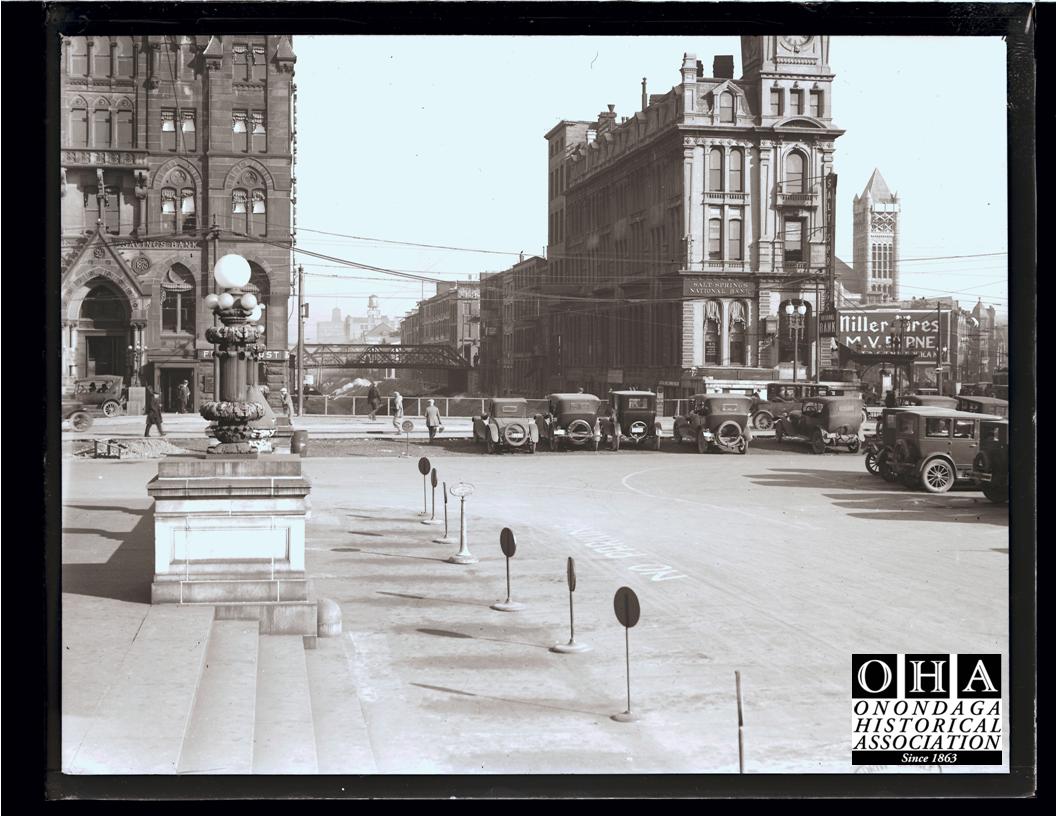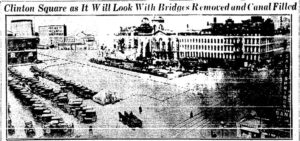
“Syracuse is one, division lines are done!”—Official Proclamation, October 23, 1924
On October 23rd, 1924, Salina Street was reopened to traffic following the removal of the bridge over the Erie Canal, the filling in of the canal, and the paving of the surface. The Erie Canal was officially closed to navigation in 1917 and was replaced by the Barge Canal, which bypassed downtown Syracuse. In 1923, the engineering wonder of the 1820s was filled, graded, and turned into a parking lot for Model T’s and other automobiles in Clinton Square.
In the 1930s, the parking lot was landscaped and remained divided by Erie Boulevard until a 2001 renovation created the space we are familiar with today. During the winter months, Syracusans can go ice skating on the reflecting pool, reminiscent of the days when people skated on the frozen canal.
Why was the Erie Canal filled in?
Prior to the canal being filled in and the removal of the Salina Street bridge, the Syracuse Herald reported the following on July 13th, 1921, reflecting a popular opinion at the time:
“The Erie Canal between Salina and Clinton streets appears to be a favorite gathering place for scum and refuse. The wind sweeps papers, boxes, pieces of wood and other rubbish into this cove and leaves it there. The wind tends to clear the main channel of the canal of such rubbish, but does not affect such secluded places.
Weeds from the bottom of the canal have grown to the surface and add to the general unsightly collection. They gather the other refuse and aid in giving the canal the general appearance of a dumping place. Tuesday morning there was such a heap of rubbish just east of the Salina Street bridge that the railing was crowded with spectators.
The refuse remains—a menace to public health.”
On June 23, 1923, Syracuse began to move forward, and work to fill in the Erie Canal began.
 “A few pounds of earth, shoveled into the historical canal basin at Clinton Square by Dr. Frederick W. Betts, representing the South Side, and John Gang, representing the North Side, served to mark the high spot in the crowded afternoon’s program. It symbolized, as Mayor John H. Walrath pointed out, “the erasure of a line that has divided the community and hindered its progress almost from the beginning.”
“A few pounds of earth, shoveled into the historical canal basin at Clinton Square by Dr. Frederick W. Betts, representing the South Side, and John Gang, representing the North Side, served to mark the high spot in the crowded afternoon’s program. It symbolized, as Mayor John H. Walrath pointed out, “the erasure of a line that has divided the community and hindered its progress almost from the beginning.”
“This,” he said, “is an historic moment. The city has at last secured the possession of the old Erie Canal which has split the city in two so harmfully.
“We are today erasing a dividing line, imaginary as though it may be, which has impeded and obstructed the growth and cooperation of the community for many, many years. Today, on our municipal holiday, we hold it fitting to call upon a representative of the South Side and of the North Side to begin the work of blotting out this line.”
“They are beginning an improvement which I promise you will progress as rapidly as is humanly possible.” (Syracuse Herald, June 24, 1923)
The Syracuse Herald even printed a song about the filling in of the canal on October 28th:
“It’s Gone Forver” Official Celebration Song
To be sung to the tune of “It Ain’t Goin’ Rain No Mo‘”
1-North Salina Street laid to a sewer
And by that sewer North died
An dat n merchant’s inquest
They called it “sewer-side”
Chorus
Oh, there aint any bridge any more any more
There ain’t any bridge any more.
But how in — can the other folks tell
There ain’t any bridge any more.
2-You all remember the only canal bridge
It used to go up and down
The only thing the — thing did
Was separate the town
Chorus
3-Oh, we’ll have four days of jubilee
Brass bands will be playing tunes,
It’ll be the greatest awakening
That has happened in many moons
4-Look at the Smile on Walrath’s face,
he sure is full of pride
The reason is–one Salina Street
There is no more North Side.”

